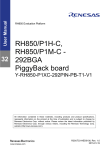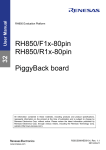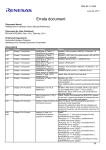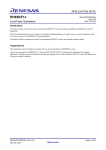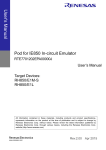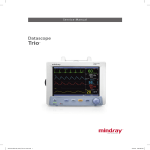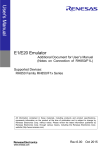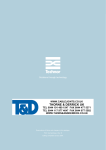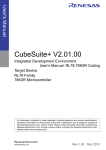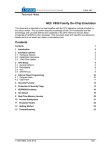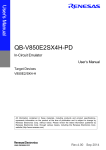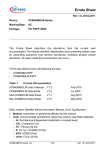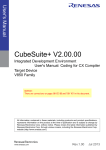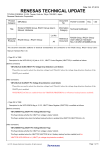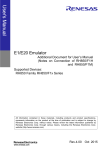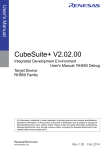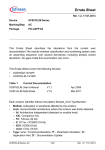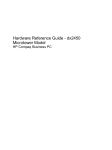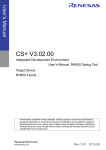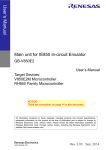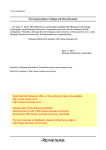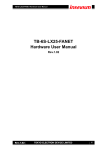Download Pod for IE850 In-circuit Emulator RTE7701412EPA00000R User`s
Transcript
User's Manual Pod for IE850 In-circuit Emulator RTE7701412EPA00000R User’s Manual Target Devices: RH850/D1M2H RH850/D1M2 All information contained in these materials, including products and product specifications, represents information on the product at the time of publication and is subject to change by Renesas Electronics Corp. without notice. Please review the latest information published by Renesas Electronics Corp. through various means, including the Renesas Electronics Corp. website (http://www.renesas.com). www.renesas.com Rev.1.00 Oct 2015 Notice 1. Descriptions of circuits, software and other related information in this document are provided only to illustrate the operation of semiconductor products and application examples. You are fully responsible for the incorporation of these circuits, software, and information in the design of your equipment. Renesas Electronics assumes no responsibility for any losses incurred by you or third parties arising from the use of these circuits, software, or information. 2. Renesas Electronics has used reasonable care in preparing the information included in this document, but Renesas Electronics does not warrant that such information is error free. Renesas Electronics assumes no liability whatsoever for any damages incurred by you resulting from errors in or omissions from the information included herein. 3. Renesas Electronics does not assume any liability for infringement of patents, copyrights, or other intellectual property rights of third parties by or arising from the use of Renesas Electronics products or technical information described in this document. No license, express, implied or otherwise, is granted hereby under any patents, copyrights or other intellectual property rights of Renesas Electronics or others. 4. You should not alter, modify, copy, or otherwise misappropriate any Renesas Electronics product, whether in whole or in part. Renesas Electronics assumes no responsibility for any losses incurred by you or third parties arising from such alteration, modification, copy or otherwise misappropriation of Renesas Electronics product. 5. Renesas Electronics products are classified according to the following two quality grades: “Standard” and “High Quality”. The recommended applications for each Renesas Electronics product depends on the product’s quality grade, as indicated below. “Standard”: Computers; office equipment; communications equipment; test and measurement equipment; audio and visual equipment; home electronic appliances; machine tools; personal electronic equipment; and industrial robots etc. “High Quality”: Transportation equipment (automobiles, trains, ships, etc.); traffic control systems; anti-disaster systems; anticrime systems; and safety equipment etc. Renesas Electronics products are neither intended nor authorized for use in products or systems that may pose a direct threat to human life or bodily injury (artificial life support devices or systems, surgical implantations etc.), or may cause serious property damages (nuclear reactor control systems, military equipment etc.). You must check the quality grade of each Renesas Electronics product before using it in a particular application. You may not use any Renesas Electronics product for any application for which it is not intended. Renesas Electronics shall not be in any way liable for any damages or losses incurred by you or third parties arising from the use of any Renesas Electronics product for which the product is not intended by Renesas Electronics. 6. You should use the Renesas Electronics products described in this document within the range specified by Renesas Electronics, especially with respect to the maximum rating, operating supply voltage range, movement power voltage range, heat radiation characteristics, installation and other product characteristics. Renesas Electronics shall have no liability for malfunctions or damages arising out of the use of Renesas Electronics products beyond such specified ranges. 7. Although Renesas Electronics endeavors to improve the quality and reliability of its products, semiconductor products have specific characteristics such as the occurrence of failure at a certain rate and malfunctions under certain use conditions. Further, Renesas Electronics products are not subject to radiation resistance design. Please be sure to implement safety measures to guard them against the possibility of physical injury, and injury or damage caused by fire in the event of the failure of a Renesas Electronics product, such as safety design for hardware and software including but not limited to redundancy, fire control and malfunction prevention, appropriate treatment for aging degradation or any other appropriate measures. Because the evaluation of microcomputer software alone is very difficult, please evaluate the safety of the final products or systems manufactured by you. 8. Please contact a Renesas Electronics sales office for details as to environmental matters such as the environmental compatibility of each Renesas Electronics product. Please use Renesas Electronics products in compliance with all applicable laws and regulations that regulate the inclusion or use of controlled substances, including without limitation, the EU RoHS Directive. Renesas Electronics assumes no liability for damages or losses occurring as a result of your noncompliance with applicable laws and regulations. 9. Renesas Electronics products and technology may not be used for or incorporated into any products or systems whose manufacture, use, or sale is prohibited under any applicable domestic or foreign laws or regulations. You should not use Renesas Electronics products or technology described in this document for any purpose relating to military applications or use by the military, including but not limited to the development of weapons of mass destruction. When exporting the Renesas Electronics products or technology described in this document, you should comply with the applicable export control laws and regulations and follow the procedures required by such laws and regulations. 10. It is the responsibility of the buyer or distributor of Renesas Electronics products, who distributes, disposes of, or otherwise places the product with a third party, to notify such third party in advance of the contents and conditions set forth in this document, Renesas Electronics assumes no responsibility for any losses incurred by you or third parties as a result of unauthorized use of Renesas Electronics products. 11. This document may not be reproduced or duplicated in any form, in whole or in part, without prior written consent of Renesas Electronics. 12. Please contact a Renesas Electronics sales office if you have any questions regarding the information contained in this document or Renesas Electronics products, or if you have any other inquiries. (Note 1) “Renesas Electronics” as used in this document means Renesas Electronics Corporation and also includes its majorityowned subsidiaries. (Note 2) “Renesas Electronics product(s)” means any product developed or manufactured by or for Renesas Electronics. (2012.4) Important Before using this product, be sure to read this user’s manual carefully. Keep this user’s manual, and refer to it when you have questions about this product. Emulator: "Emulator" in this document collectively refers to the following products manufactured by Renesas Electronics Corp. (1) IE850 emulator main unit (2) Pod "Emulator" herein encompasses neither the customer's user system nor the host machine. Purpose of use of the emulator: This emulator is a device to support the development of systems that use products from the RH850/D1x series of Renesas microcontrollers. It provides support for system development in both software and hardware. Be sure to use this emulator correctly according to said purpose of use. Please avoid using this emulator other than for its intended purpose of use. For those who use this emulator: This emulator can only be used by those who have carefully read the user’s manual and know how to use it. Use of this emulator requires basic knowledge of electric circuits, logical circuits, and MCUs. When using the emulator: (1) This product is a development-support unit for use in your program development and evaluation stages. When a program you have finished developing is to be incorporated in a mass-produced product, the judgment as to whether it can be put to practical use is entirely your own responsibility, and should be based on evaluation of the device on which it is installed and other experiments. (2) In no event shall Renesas Electronics Corp. be liable for any consequence arising from the use of this product. (3) Renesas Electronics Corp. strives to provide workarounds for and correct trouble with products malfunctions, with some free and some incurring charges. However, this does not necessarily mean that Renesas Electronics Corp. guarantees the provision of a workaround or correction under any circumstances. (4) The product covered by this document has been developed on the assumption that it will be used for program development and evaluation in laboratories. Therefore, it does not fall within the scope of applicability of the Electrical Appliance and Material Safety Law and protection against electromagnetic interference when used in Japan. (5) Renesas Electronics Corp. cannot predict all possible situations and possible cases of misuse that carry a potential for danger. Therefore, the warnings in this user's manual and the warning labels attached to the emulator do not necessarily cover all such possible situations and cases. The customer is responsible for correctly and safely using this emulator. (6) The product covered by this document has not been through the process of checking conformance with UL or other safety standards and IEC or other industry standards in countries other than Japan. This fact must be taken into account when the product is taken from Japan to another country. (7) Renesas Electronics Corp. will not assume responsibility for direct or indirect damage caused by an accidental failure or malfunction of this emulator. When disposing of the emulator: Penalties may be applicable for incorrect disposal of this waste, in accordance with your national legislation. Usage restrictions: The emulator has been developed as a means of supporting system development by users. Therefore, do not use it as an embedded device in other equipment. Also, do not use it to develop systems or equipment for use in the following fields. (1) Transportation and vehicular (2) Medical (equipment that has an involvement in human life) (3) Aerospace (4) Nuclear power control (5) Undersea repeaters If you are considering the use of the emulator for one of the above purposes, please be sure to consult your local distributor. About product changes: We are constantly making efforts to improve the design and performance of this emulator. Therefore, the specification or design of this emulator, or this user's manual, may be changed without prior notice. About rights: (1) We assume no responsibility for any damage or infringement on patent rights or any other rights arising from the use of any information, products or circuits presented in this user’s manual. (2) The information or data in this user’s manual does not implicitly or otherwise grant a license to patent rights or any other rights belonging to Renesas or to a third party. (3) This user’s manual and this emulator are copyrighted, with all rights reserved by Renesas. This user’s manual may not be copied, duplicated or reproduced, in whole or part, without prior written consent from Renesas. About diagrams: Some diagrams in this user’s manual may differ from the objects they represent. Precautions for Safety This chapter, by showing the relevant diagrammatic symbols and their meanings, describes the precautions which should be taken in order to use this product safely and properly. Be sure to read and understand this chapter before using this product. Contact us if you have any questions about the precautions described here. WARNING WARNING indicates a potentially dangerous situation that will cause death or heavy wound unless it is avoided. CAUTION CAUTION indicates a potentially dangerous situation that will cause a slight injury or a medium-degree injury unless it is avoided. In addition to the two above, the following are also used as appropriate. means WARNING or CAUTION. Example: CAUTION AGAINST AN ELECTRIC SHOCK means PROHIBITION. Example: DISASSEMBLY PROHIBITED means A FORCIBLE ACTION. Example: UNPLUG THE POWER CABLE FROM THE RECEPTACLE. WARNING Warnings for AC Power Supply: If the separately sold AC power cable for the power adaptor does not fit the receptacle, do not alter the AC power cable and do not plug it in forcibly. Failure to comply may cause electric shock and/or fire. Use an AC power cable which complies with the safety standard of the country. Do not touch the plug of the AC power cable when your hands are wet. This may cause electric shock. This product is connected signal ground with frame ground. If your developing product is transformless (not having isolation transformer of AC power), this may cause electric shock. Also, this may give an unrepairable damage to this product and your developing one. While developing, connect AC power of the product to commercial power through isolation transformer in order to avoid these dangers. Connect the plug of the AC power cable to the outlet when connecting this emulator and the user system in order to eliminate differences in potential between the grounds of the emulator and of the user’s system. If other equipment is connected to the same branch circuit, care should be taken not to overload the circuit. When installing this equipment, insure that a reliable ground connection is maintained. If you smell a strange odor, hear an unusual sound, or see smoke coming from this product, then disconnect power immediately by unplugging the AC power cable from the outlet. Do not use this as it is because of the danger of electric shock and/or fire. In this case, contact your local distributor. Before setting up this emulator and connecting it to other devices, turn off power or remove a power cable to prevent injury or product damage. WARNING Warnings to Be Taken for This Product: Do not disassemble or modify this product. Personal injury due to electric shock may occur if this product is disassembled and modified. Disassembling and modifying the product will void your warranty. Make sure nothing falls into the cooling fan on the top panel, especially liquids, metal objects, or anything combustible. Note the following point on products which have a cooling fan. When the fan does not operate due to, for example, a fault, the temperature of the emulator may be high enough to potentially cause injuries (such as burns) on contact. Accordingly, if the fan does not operate after the emulator is turned on, turn the emulator off immediately and send it to be repaired. Warning for Installation: Do not set this product in water or areas of high humidity. Make sure that the product does not get wet. Spilling water or some other liquid into the product may cause unrepairable damage. Warning for Use Environment: Care should be taken to ensure that the emulator is not used at temperatures exceeding the maximum ambient temperature. CAUTION Point for Caution Regarding the Power Adaptor: Use only the dedicated power adaptor which is separately sold. Also, do not use the power adaptor for other equipment. Cautions to Be Taken for Turning On the Power: Take the steps below to turn the power to the emulator ON or OFF. Not following the order might cause damage to the user system or emulator. When turning on the power: (1) Turn on the emulator; (2) turn on the user system; (3) connect the debugger (emulator software) When turning off the power: (1) Disconnect the debugging session (emulator software); (2) turn off the user system; (3) turn off the emulator Cautions to Be Taken for Handling This Product: Use caution when handling the emulator. Be careful not to apply a mechanical shock. Do not touch the connector pins of the emulator and the user system directly. Doing so may lead to the discharge of static electricity and so damage the internal circuits. When attaching and removing the pod cable, hold a fixture (such as a connector) to avoid pulling the pod cable. Do not pull the emulator and board by the communications interface cable or the cable for connecting the user system since this might lead to the breaking of wires in the pod cable. Also, do not flex the pod cable excessively when installing the cable since this might lead to the breaking of wires in the cable. Do not use inch-size screws for this equipment. The screws used in this equipment are all ISO (meter-size) type screws. Caution to Be Taken for System Malfunctions: If the emulator malfunctions because of interference like external noise, do the following to remedy the trouble. (1) Exit the debugger (emulator software), and shut OFF the emulator and the user system. (2) After a lapse of 10 seconds, turn ON the power of the emulator and the user system again, then launch the debugger (emulator software). CAUTION Note on Heat Generation While the Product is in Use: Using this product for a long time might cause the product to have a high temperature. If this is the case, care must be taken to avoid injuries due to the heat such as low temperature burns. Note on the Cover of the Emulation Pod: Be sure to use the product with the cover of the emulation pod in place. Note on Transporting the Product: When sending your product for repair, use the packing box and cushioning material supplied with the product when it was delivered to you and specify caution in handling (handling as precision equipment). If packing of your product is not complete, it may be damaged during transportation. When you pack your product in a bag, make sure to use the conductive plastic bag supplied with the product. If you use a different bag, it may lead to further trouble with your product due to static electricity. Caution to Be Taken for Disposal: Penalties may be applicable for incorrect disposal of this waste, in accordance with your national legislation. European Union Regulatory Notices: The WEEE (Waste Electrical and Electronic Equipment) regulations put responsibilities on producers for the collection and recycling or disposal of electrical and electronic waste. Return of WEEE under these regulations is applicable in the European Union only. This equipment (including all accessories) is not intended for household use. After use the equipment cannot be disposed of as household waste, and the WEEE must be treated, recycled and disposed of in an environmentally sound manner. Renesas Electronics Europe GmbH can take back end of life equipment, register for this service at “http://www.renesas.eu/weee”. How to Use This Manual Readers This manual is intended for users who wish to perform debugging using the RTE7701412EPA00000R (generic name: pod). The readers of this manual are assumed to be familiar with the device functions and usage, and to have knowledge of debuggers. Purpose This manual is intended to give users an understanding of the basic specifications and correct usage of the pod. Organization This manual is divided into the following sections. How to Read This Manual Overview Names and Functions of Hardware Setup Procedure Notes Optional Product Maintenance and Warranty It is assumed that the readers of this manual have general knowledge in the fields of electrical engineering, logic circuits, and microcontrollers. This manual describes the basic setup procedures and how to set switches. To understand the overall functions and usages of the IE850 → Read this manual in the order of Contents. To know the manipulations, command functions, and other software-related settings of the IE850 → See the user’s manual of the debugger to be used. Conventions Note: Footnote for item marked with Note in the text Caution: Information requiring particular attention Remark: Supplementary information Numeric representation: Binary ... xxxx or xxxxB Decimal ... xxxx Hexadecimal ... xxxxH Prefix indicating power of 2 (address space, memory capacity): K (kilo): 210 = 1,024 M (mega): 220 = 1,0242 Terminology The meanings of the terms used in this manual are described in the table below. Term Related Documents Meaning Target device This is the device to be emulated. Target system This is the system to be debugged (system provided by the user). This includes the hardware and software provided by the user. IE850 Name for IE850 emulator systems in general. IE850 main QB-V850E2 Pod The pod is a peripheral of the IE850 main unit and serves as the interface with the target system. Emulator This is the product to emulate the target device. Refers to the IE850 main unit and pod in this document. Please refer to the related documents listed below in addition to this manual before using the product. Name of documents Release note RH850 POD for IE850 Release Note (Restrictions on the Document No. R20UT3545E Emulator when Used with CS+) IE850 main unit Main unit for IE850 In-circuit Emulator R20UT0824E QB-V850E2 User’s Manual Exchange adapter Exchange adapter for adapting the (EA) RTE7701412EPA00000R to 484-Pin BGA connection Exchange adapter for adapting the R20UT2991E R20UT2992E RTE7701412EPA00000R to 376-Pin BGA connection Caution: Related documents listed above are subject to change without prior notice. Thus, make sure that you have the latest documents for use in design. Table of Contents Important ................................................................................................................................................ 3 Precautions for Safety ............................................................................................................................ 5 How to Use This Manual ..................................................................................................................... 10 1. Overview .......................................................................................................................................... 14 1.1 1.2 1.3 Hardware specification ........................................................................................................................................... 15 System overview ..................................................................................................................................................... 16 Functional overview................................................................................................................................................ 18 1.3.1 Program execution function ......................................................................................................................... 20 1.3.2 Reset function ............................................................................................................................................... 20 1.3.3 Event function (Detection of specific operations) ........................................................................................ 21 1.3.4 Break functions (Program execution stop) ................................................................................................... 24 1.3.5 Trace function (Program execution history) ................................................................................................. 25 1.3.6 Performance measurement ........................................................................................................................... 27 1.3.7 Memory register access function .................................................................................................................. 28 1.3.8 Peripheral debugging function ..................................................................................................................... 28 1.3.9 Reset masking .............................................................................................................................................. 28 1.4 Regulatory notices .................................................................................................................................................. 29 1.5 Block overview ....................................................................................................................................................... 30 1.6 Package contents ..................................................................................................................................................... 30 2. Names and Functions of Hardware .................................................................................................. 31 2.1 2.2 Pod .......................................................................................................................................................................... 31 IE850 main unit....................................................................................................................................................... 32 3. Setup Procedure ............................................................................................................................... 34 3.1 3.2 Install the debugger ................................................................................................................................................. 34 Set up the pod and connect the IE850 main unit ..................................................................................................... 35 3.2.1 Removing pod cover .................................................................................................................................... 35 3.2.2 Clock Settings .............................................................................................................................................. 35 3.2.3 Connecting the IE850 main unit to the pod .................................................................................................. 36 3.3 Connect the target system ....................................................................................................................................... 38 3.3.1 Connection of the pod and target system...................................................................................................... 38 3.3.2 Connecting the USB cable and AC adaptor ................................................................................................. 39 3.4 Turn on the IE850 main unit ................................................................................................................................... 39 3.5 Turn on the target system ........................................................................................................................................ 40 3.6 Start the debugger ................................................................................................................................................... 40 3.7 Shut down procedure .............................................................................................................................................. 40 4. Notes ................................................................................................................................................ 41 4.1 Notes for differences between actual device and emulator ..................................................................................... 41 4.1.1 Behavior after target system is powered on.................................................................................................. 41 4.1.2 DBTRAP instruction .................................................................................................................................... 41 4.1.3 Function of On-chip debugging emulator .................................................................................................... 41 4.1.4 Serial programming ...................................................................................................................................... 41 4.1.5 Downloaded programs ................................................................................................................................. 41 4.1.6 Halt mode ..................................................................................................................................................... 42 4.1.7 Oscillator ...................................................................................................................................................... 42 4.1.8 Current drawn ............................................................................................................................................... 42 4.1.9 ECC errors .................................................................................................................................................... 42 4.1.10 ISOVDD pin ................................................................................................................................................. 42 4.1.11 REG0C pin ................................................................................................................................................... 42 4.1.12 VSS pins for each power subsystem ............................................................................................................ 42 4.1.13 A/D converter ............................................................................................................................................... 43 4.1.14 DDR2-SDRAM interface ............................................................................................................................. 43 4.1.15 Power-On-Clear Reset (POC) function ........................................................................................................ 43 4.1.16 PWRCTL pin................................................................................................................................................ 43 4.1.17 PWRGD pin ................................................................................................................................................. 43 4.1.18 Voltage on the A0VCC pin due to leakage current ...................................................................................... 43 4.1.19 FLMD0 pin................................................................................................................................................... 43 4.1.20 Operations in response to resets and interrupts when an emulator is in use ................................................. 44 4.1.21 OTP flag ....................................................................................................................................................... 44 4.1.22 Option byte register ...................................................................................................................................... 44 4.2 Cautionary Notes on Debugging ............................................................................................................................. 45 4.2.1 Hardware break (Access) function ............................................................................................................... 45 4.2.2 Initialization of the RAM area ...................................................................................................................... 45 4.2.3 Reset of pins ................................................................................................................................................. 45 4.2.4 Trace function .............................................................................................................................................. 45 4.2.5 Power-saving modes .................................................................................................................................... 46 4.2.6 Power-saving modes when the target system is not connected .................................................................... 46 4.2.7 Software resets and debugging ..................................................................................................................... 46 4.2.8 Interrupts when stepped execution is in use ................................................................................................. 46 4.2.9 Stepped execution of the HALT instruction ................................................................................................. 46 4.2.10 Stepped execution of an instruction which would lead to a transition to the DeepSTOP mode................... 47 4.2.11 Access to I/O resources in the MCU ............................................................................................................ 47 4.2.12 Performance measurement ........................................................................................................................... 47 4.2.13 Registers in serial flash memory interface A (SFMA) ................................................................................. 47 4.2.14 Pin-reset mask function ................................................................................................................................ 47 5. Optional Product .............................................................................................................................. 48 5.1 Long term trace option ............................................................................................................................................ 48 5.1.1 General ......................................................................................................................................................... 48 5.1.2 Setup procedure ............................................................................................................................................ 49 5.1.3 Cautionary note when using the QB-V850E2-SP ........................................................................................ 49 6. Maintenance and Warranty .............................................................................................................. 50 6.1 6.2 6.3 6.4 Maintenance ............................................................................................................................................................ 50 Warranty ................................................................................................................................................................. 50 Repair provisions .................................................................................................................................................... 51 How to request repairs ............................................................................................................................................ 51 Appendix A Characteristics of Target Interface ............................................................................. 52 Pod for IE850 In-circuit Emulator 1. 1. Overview Overview The RTE7701412EPA00000R (pod) is used together with the QB-V850E2 (IE850 main unit) in order to emulate RH850/D1x series microcontrollers from Renesas Electronics Corp. The IE850 can be used to debug hardware and software efficiently when developing systems using the target device. IE850 main unit 94 mm 75 mm Pod (this product) 104 mm 43 mm Figure 1-1 R20UT3014EJ0100 Oct 01, 2015 Rev. 1.00 External Appearance Page 14 of 60 Pod for IE850 In-circuit Emulator 1.1 1. Overview Hardware specification The following table describes hardware specifications of the pod. Table 1-1 Pod Hardware Specifications Parameter Target device Specification RH850/D1M2H、RH850/D1M2 RVCC、MVCC、 SFVCC、TVCC 3.3 V REG0VCC、REG1VCC、 Target system interface voltage* OSCVCC、EVCC、PLLVCC、 B0VCC、B1VCC、B2VCC、 3.3 V or 5.0 V B3VCC、B4VCC、ISMVCC、 A0VCC、A0VREF ZPDVCC、ZPDVREF 5.0 V Maximum operating frequency 240MHz Input frequency of the oscillator 8MHz (the oscillator on the pod is used) Operating temperature range 0 to 40 °C (No condensation) Storage temperature range −15 to 60 °C (No condensation) Note: The other terminals are connected to the internal power of the IE850. R20UT3014EJ0100 Oct 01, 2015 Rev. 1.00 Page 15 of 60 Pod for IE850 In-circuit Emulator 1.2 1. Overview System overview The system configuration is described below. The pod cannot be used on its own. The IE850, an AC adaptor, and sockets are also required. These are sold separately. IE850 main unit (sold separately) USB cable Host machine Pod (this product) AC adaptor Exchange adaptor (sold separately) Space adaptor (height adjustment, sold separately) AC adaptor (Sold separately for each country. Refer to the user’s manual for the IE850 main unit.) Target connector Sockets (sold separately) Refer to Table 1-2. Mount adaptor (mounting target device, sold separately) Target system Figure 1-2 R20UT3014EJ0100 Oct 01, 2015 Rev. 1.00 System Configuration (When the BGA Package is Selected) Page 16 of 60 Pod for IE850 In-circuit Emulator 1. Overview The following table describes the corresponding sockets for the target device. Table 1-2 Sockets for the Target Device Target Device RH850/D1M2H Socket Package:BGA BGA484(PRBG0484FF-A) Exchange Adaptor RTE7701412CBF484T000R (*1) Emulator Connector Target Connector BSSOCKET484Z2627RE21N (*2) Space Adaptor Mount Adaptor CSSOCKET484Z2627RE03 (*2) CSSOCKET484Z2627RE04(*2) LSPACK484Z2627RE01 (*2) Target Device RH850/D1M2 Socket Package:BGA BGA376(PRBG0376FB-A) Exchange Adaptor RTE7701410CBF376T000R (*1) Emulator Connector Target Connector BSSOCKET376Z2223RE21N (*2) Space Adaptor Mount Adaptor CSSOCKET376Z2223RE03(*2) CSSOCKET376Z2223RE04(*2) LSPACK376Z2223RE01(*2) Notes *1: Separately sold product (can be purchased from Renesas Electronics Corporation) *2: Separately sold product (can be purchased from Tokyo Eletech Corporation) R20UT3014EJ0100 Oct 01, 2015 Rev. 1.00 Page 17 of 60 Pod for IE850 In-circuit Emulator 1.3 1. Overview Functional overview IE850 is provided with a wealth of debugging functions to enable efficient program debugging, in addition to being used to emulate the operation of a target device. An overview of the functions is provided in this section. Some functions are not supported, depending on the debugger to be used. See also the manual of the debugger to be used to confirm. Table 1-3 System Specifications (1/2) Parameter Emulation memory capacity Specification On-board flash memory Same as target devices. On-board RAM Same as target devices. External memory None Program execution functions Step execution Available Reset functions Forced reset Available Event functions Hardware breakpoints 12 points Post-execution events 8 points CPU access events 8 points DMA access events 4 points CPU sequential events 4 steps One event is created by combining the functions below (in up to 4 steps). Post-execution event or CPU access event or number of passes (measured by the 32-bit counter) DMA sequential events 3 steps One event is created by combining the functions below (in up to 3 steps). DMA access event or number of passes (measured by the 32-bit counter) Break functions Hardware break Available (refer to the “Hardware breakpoints” and “Postexecution events” items in the Event functions category.) Software break Available On-board flash memory: 2000 points On-board RAM: Setting is not allowed R20UT3014EJ0100 Oct 01, 2015 Forced break Available Other Trace-full break, delay trigger break Rev. 1.00 Page 18 of 60 Pod for IE850 In-circuit Emulator Table 1-3 1. Overview System Specifications (2/2) Parameter Trace functions Specification Real-time trace mode Available Non-real-time trace mode Available Type of trace data Branch-source PC, branch-destination PC, access PC, access address, accessed data, DMA access cycle, time stamp Trace events Section trace, Qualified trace, Delay trigger trace Memory capacity 9 Mbytes (512 K frames) *One frame = one set of branch information = two cycles (branch source address and branch destination address) 2.25 Gbytes (Approx. 128 M frames) *One frame = one set of branch information = two cycles (branch source address and branch destination address) (When using the long term trace option) Performance measurement functions Conditions for recording trace memory Non-stop mode, trace-full stop mode, trace-full break mode, delay trigger stop mode, delay trigger break mode Time (1) Measurement section From run to break Items measured Execution time Performance 32-bit counters Time (2) Measurement section From run to break, or between two event points Items measured Execution time, total execution time, pass count, maximum execution time, minimum execution time Performance 32-bit counters (for three sections) Other Items measured than time Measurement section From run to break, or between two event points Items measured Latest value, total value, pass count, maximum value, minimum value Performance 32-bit counters (for four sections) Other functions R20UT3014EJ0100 Oct 01, 2015 Number of instructions executed (all or branches only), number of interrupts accepted (EI level or FE level), number of exceptions accepted (instruction asynchronous or instruction synchronous), clock cycles (all, while interrupts are inhibited, or other than for the processing of interrupts), number of instruction fetches requested, number of hits on the instruction cache Memory register access function, peripheral debugging function, reset mask function Rev. 1.00 Page 19 of 60 Pod for IE850 In-circuit Emulator 1.3.1 1. Overview Program execution function The program execution function enables program execution equivalent to that of the target device. The executed program can be stopped under various conditions by using the break functions (1.3.4 Break functions (program execution stop)). The operation of only a function can be checked by executing a program, because a program can be executed from any address. (1) Step execution function The step execution function can be used to execute instructions one by one, in units of assembly instructions (single stepping) or lines of C language source code (source level stepping). In the case of single stepping, only instructions that are purely in the stepwise flow can be executed, because interrupts are not acknowledged during single step execution. Take care of the following point, however, in the case of source level stepping. Caution Step execution to be performed at the source level is performed by a debugger using the break function. In this case, interrupts are acknowledged in step execution. Consequently, if processing at the interrupt destination cannot be completed, step execution may not be completed. For handling such a case, see the manual of the debugger. 1.3.2 Reset function The reset function is for resetting the CPU from the debugger. The function is used to rewrite the flash memory (after a program is downloaded followed by rewriting a part of the flash memory), start program execution from the reset vector, or initialize the CPU during debugging R20UT3014EJ0100 Oct 01, 2015 Rev. 1.00 Page 20 of 60 Pod for IE850 In-circuit Emulator 1.3.3 1. Overview Event function (Detection of specific operations) The event function is used to detect specific fetching or other access by monitoring the bus cycle of the CPU and the external master such as DMA. Operations where the instruction at an address is executed by the CPU or access to a variable is made by the CPU or the external master can be detected. Such specific operations are referred to as events. The event function is used by the hardware break function, trace function, and performance measurement function. Events that can be registered by the event function are shown below. (1) Hardware breakpoint event The CPU is equipped with an event function. Events take the form of executing the instruction at an address or access to an address. Events can only be used with the hardware break function. Up to 12 points can be specified as hardware break events. Four of these are shared with the access address event. Eight points are for dedicated use with the execution of instructions at particular addresses. [Function to be used] Hardware break function [Specifiable detection condition] Execution of instruction at an address Access to an address and data Caution Hardware break events are in principle detected before executing the corresponding instruction unless a data condition for read access is specified as a detection condition. (2) Post-execution events Post-execution events are detected when the instruction at an address is executed. These events are shared by the trace and time measurement functions. Address ranges are specifiable for post-execution events. Up to eight points can be specified as post-execution events, but two points are used for an event where the execution address is specified as a range. In other words, if all events are specified with ranges of execution addresses, only four events can be specified. [Functions for use with these events] Trace function Time measurement function [Specifiable detection condition] Execution address (a range can be specified) Caution Specifications of the hardware and supported functions might not be consistent depending on the debugger in use. Check the manual and other documents for the debugger you will be using. R20UT3014EJ0100 Oct 01, 2015 Rev. 1.00 Page 21 of 60 Pod for IE850 In-circuit Emulator (3) 1. Overview CPU access event An access event is detected as access (reading or writing) to an address made by the CPU or the PCU. These events are shared by the trace and time measurement functions. Conditions for detection listed below can be specified. Up to eight points can be specified as an access event, but two points are used for an event where the access address is specified as a range. In other words, if all events are specified with ranges of addresses for access, only four events can be specified. [Functions for use with these events] Trace function Time measurement function [Specifiable detection conditions] Access to an address (a range can be specified) Accessed data Access size State of access (reading, writing, or both reading and writing) Caution Specifications of the hardware and supported functions might not be consistent depending on the debugger to be used. Thus, also check the manual and other related documents for the debugger you will be using. (4) DMA access event An access event is detected as access (reading or writing) to an address made by the DMA. These events are not available for the time measurement function. Conditions for detection listed below can be specified. Up to four points can be specified as an access event, but two points are used for an event where the access address is specified as a range. In other words, if all events are specified with ranges of addresses for access, only two events can be specified. [Function for use with these events] Trace function [Specifiable detection conditions] Access to an address (a range can be specified) Accessed data Access size State of access (reading, writing, or both reading and writing) Caution Specifications of the hardware and supported functions might not be consistent depending on the debugger to be used. Thus, also check the manual and other related documents for the debugger you will be using. R20UT3014EJ0100 Oct 01, 2015 Rev. 1.00 Page 22 of 60 Pod for IE850 In-circuit Emulator (5) 1. Overview CPU sequential event The CPU sequential event function is used to combine post-execution events (items described in (2) above) and events registered as CPU access events (items described in (3) above) with a pass count to make a single event. Linked events are used to detect specific sequences such as cases where the instruction at an address is executed after access to a variable. Caution This function might not be supported depending on the debugger in use. Thus, also check the manual and other related documents for the debugger you will be using. (6) DMA sequential event The DMA sequential event function is used to combine events registered as DMA access events (items described in (4) above) with a pass count to make a single event. Linked events are used to detect specific sequences such as cases where variables A, B, and C are executed in the order of A, B, and C. Caution This function might not be supported depending on the debugger in use. Thus, also check the manual and other related documents for the debugger you will be using. R20UT3014EJ0100 Oct 01, 2015 Rev. 1.00 Page 23 of 60 Pod for IE850 In-circuit Emulator 1.3.4 1. Overview Break functions (Program execution stop) The break functions are used to stop program execution. With the IE850, program execution can be stopped under the following various conditions. See (1) to (4) for an overview of each break function. Table 1-4 Conditions for Breaks and their Types Condition for break Stopping after executing the instruction at an address Type of break Hardware break function Software break function Stopping after access to a variable Hardware break function Forcibly stopping Forced break Stopping if trace acquisition matches a certain condition Trace-full break function Trace delay break function Variable values can be checked during a break and a program can be executed again by changing register values, because the CPU operates even during a break (while the program is stopped). Interrupts generated during the break are suspended, because basically peripheral functions also operate during the break. Use the peripheral debugging function (1.3.8 Peripheral debugging function) to stop peripheral functions during the break. (1) Hardware break The hardware break function is used to observe the CPU bus cycles and set a break for a specific fetch or access operation. For example, a break is set by detecting a state where an address has been executed or a variable has been accessed. For states that can be set and cautionary notes, see 1.3.3 Event function (Detection of specific operations). (2) Software break The software break function is used to set a break when a specific address has been executed (fetched). A break is set by temporarily replacing the instruction code of the specified address with the instruction for a break. Caution Using the software break function leads to rewriting of the on-board flash memory whenever a break is set, deleted, or executed. This reduces the number of cycles of rewriting relative to cases where the software break function is not used. (3) Forced break This function is used to forcibly stop a program when a user wants to stop a program. (4) Other types of breaks Trace-full break function This function is used to stop a program when the trace memory is full. Delay trigger break This function is used to stop a program after acquiring a certain amount of trace data by hitting a certain event condition. Caution This function might not be supported depending on the debugger in use. Thus, also check the manual and other related documents for the debugger you will be using. R20UT3014EJ0100 Oct 01, 2015 Rev. 1.00 Page 24 of 60 Pod for IE850 In-circuit Emulator 1.3.5 1. Overview Trace function (Program execution history) The trace function is used to check the execution history (trace information) of external masters such as the CPU and DMAC. Various types of functions shown from (1) to (4) can be used in the IE850. (1) Priority of trace data acquisition This feature enables selecting the priority for the acquisition of trace data. Table 1-5 Priority of Trace Acquisition Priority of Trace Acquisition Descriptions Real-time trace mode Mode that gives priority to the program execution. If trace output is not fast enough, output of the trace information is temporarily halted. Thus, although the program runs in real time, trace information might be lost. This depends on the program being executed. Non-real-time trace mode Mode that gives priority to trace acquisition. If trace output is not fast enough, operation of the CPU is temporarily halted. Thus, the loss of trace information is suppressed* but the program loses the characteristic of real-time operations. Caution *: Using this mode will always decrease the degree of information loss compared with the real-time trace mode. However, losing information might still not be avoidable. Whether this is so depends on the program being run. (2) Types of trace data Types of trace data (trace information that can be acquired) are listed below. Table 1-6 List of Types of Trace Data Type of trace data Branch source PC value Branch destination PC value (PC stands for program counter) Access PC Descriptions Branch source and branch destination PC values can be recorded in the history. The debugger complements the program with the instructions that would otherwise be executed between branch points and displays the complemented data. Thus, a program that was practically executed could be confirmed. Caution: Execution history that can be displayed depends on the number of branches acquired. History of the PC values for executed access instructions for the memory or peripheral I/O register, access addresses, and accessed data from the CPU can be recorded. A history of reading and writing can also be recorded. Access address Accessed data Caution: Access to the program registers of the CPU (such as r1 and r2) and system registers (PSW and EIPC) cannot be recorded in the history. DMA access cycle History of access addresses and accessed data for the memory or peripheral I/O register from the DMA can be recorded. A history of reading and writing can also be recorded. Time stamp Elapsed time after starting a trace can be added to each item of trace information. The clock used in measurement for the time stamps is based on the CPU clock. R20UT3014EJ0100 Oct 01, 2015 Rev. 1.00 Page 25 of 60 Pod for IE850 In-circuit Emulator 1. Overview (3) Types of trace event Types of trace event that can be specified as conditions for acquisition are listed below. Trace information can be acquired in response to satisfying specified conditions for acquisition in combination with the function described in section 1.3.5, Trace function (Program execution history). Table 1-7 List of Types of Trace Event Type of trace event Descriptions Section trace (Acquire the history of a specific section) History can only be recorded for the specified section. For example, the execution history of a function only from its beginning to its end can be recorded. Qualified trace (Acquire the history of a specific event occurring) History can be recorded only when a specific event occurs. For example, access only to a certain variable can be recorded. Delay trigger trace (Acquire the history prior to and subsequent to the occurrence of a specific event) History after a specific event occurs can be recorded. This resembles the measurement of a signal waveform assuming the edge as a trigger when a signal is measured with the oscilloscope. For example, the history of program execution prior to and subsequent to write access to a variable can be confirmed. Also, the amount of trace information acquired after a generation of the specific trigger can be selected from three levels (i.e., small medium, or large). Caution: This function might not be supported depending on the debugger in use. Thus, also check the manual and other related documents for the debugger you will be using. R20UT3014EJ0100 Oct 01, 2015 Rev. 1.00 Page 26 of 60 Pod for IE850 In-circuit Emulator 1. Overview (4) Conditions for recording in trace memory This feature allows you to select how the trace memory is utilized. Table 1-8 List of Conditions for Recording in Trace Memory Conditions for recording in trace memory Descriptions Non-stop mode New information is written over old information so that the latest information is consistently acquired. Trace acquisition continues until a break is reached. Trace-full stop mode When trace memory becomes full, further trace information is not acquired. The program continues to run. Trace-full break mode When trace memory becomes full, further trace information is not acquired and the program is stopped. Delay trigger stop mode The latest information is consistently acquired by writing new information over old information until a specific condition occurs. After the specific condition occurs, the selected amount of trace information is acquired, after which further trace information is not acquired. The program continues to run. Caution: This function might not be supported depending on the debugger in use. Thus, also check the manual and other related documents for the debugger you will be using. Delay trigger break mode The latest information is consistently acquired by writing new information over old information until a specific condition occurs. After the specific condition occurs, the selected amount of trace information is acquired, after which further trace information is not acquired. The program is also stopped. Caution: This function might not be supported depending on the debugger in use. Thus, also check the manual and other related documents for the debugger you will be using. 1.3.6 Performance measurement Performance measurement is for measuring execution time from the time a program is started until it is stopped, the execution times of specific segments, or the items listed in Table 1-3, System Specifications (2/2). The time taken from the start of the program until it is stopped is always measured. In addition, the maximum, minimum, latest, or accumulated values and the number of passes can be selected and measured in measurement between two events. For example, measuring the execution time only for a specific function is possible. Caution Specifications of the hardware and supported functions might not be consistent depending on the debugger to be used. Thus, also check the manual and other related documents for the debugger you will be using. R20UT3014EJ0100 Oct 01, 2015 Rev. 1.00 Page 27 of 60 Pod for IE850 In-circuit Emulator 1.3.7 1. Overview Memory register access function Memory register access allows the forms of access to memories and registers listed below. (1) Register access Access to general-purpose and system registers of the CPU during breaks is possible. (2) Real-time RAM monitor Display of on-board RAM areas during program execution is possible. (3) Change of direct memory On-board RAM can be changed to a desired value during program execution. 1.3.8 Peripheral debugging function This function is used for debugging peripheral functions. The features shown below can be utilized. (1) Peripheral break function When the break function has been used to stop program execution, peripheral functions other than the watchdog timer continue to operate in general, but some peripheral functions can be stopped by using the peripheral break function. Refer to the user’s manual of the target device for information on the peripheral functions. (2) Access protection reset sequence debugging function Some peripheral IO registers require an access protection reset sequence to prevent illegal writing due to runaway execution of a program or for other reasons. Access to the corresponding group of registers is possible without affecting the reset sequence even when a break is set while the access protection reset sequence is being executed for a register where this is required. The subsequent part of the reset sequence can be continued without causing an error even when execution of the program is restarted. 1.3.9 Reset masking Two levels of reset masking are selectable on the IE850. Masking the system reset as a whole (pin reset and internal reset are masked) All resets are masked with the setting in the debug chip (microcontroller). R20UT3014EJ0100 Oct 01, 2015 Rev. 1.00 Page 28 of 60 Pod for IE850 In-circuit Emulator 1.4 1. Overview Regulatory notices ●European Union regulatory notices This product complies with the following EU Directives. (These directives are only valid in the European Union.) CE Certifications: This product complies with the following European EMC standards. ・EMC Directive (2004/108/EC) EN 55022 Class A WARNING: This is a Class A product. This equipment can cause radio frequency noise when used in the residential area. In such cases, the user/operator of the equipment may be required to take appropriate countermeasures under his responsibility. EN 55024 Information for traceability: ・Authorised representative Name: Renesas Electronics Corporation Address: TOYOSU FORESIA, 3-2-24, Toyosu, Koto-ku, Tokyo, 135-0061, Japan ・Manufacturer Name: Renesas System Design Co., Ltd. Address: 5-20-1, Josuihon-cho, Kodaira-shi, Tokyo, 187-8588, Japan ・Person responsible for placing on the market Name: Renesas Electronics Europe GmbH Address: Arcadiastrasse 10, 40472 Dusseldorf, Germany ・Trademark and Type name Trademark: Renesas Product name: IE850 Emulator Type name: RTE7701412EPA00000R Environmental Compliance and Certifications: ・Waste Electrical and Electronic Equipment (WEEE) Directive 2012/19/EC ●United States Regulatory notices on Electromagnetic compatibility This product complies with the following EMC regulation. (This is only valid in the United States.) FCC Certifications: This equipment has been tested and found to comply with the limits for a Class A digital device, pursuant to Part 15 of the FCC Rules. These limits are designed to provide reasonable protection against harmful interference when the equipment is operated in a commercial environment. This equipment generates, uses, and can radiate radio frequency energy and, if not installed and used in accordance with the instruction manual, may cause harmful interference to radio communications. Operation of this equipment in a residential area is likely to cause harmful interference in which case the user will be required to correct the interference at his own expense. This device complies with Part 15 of the FCC Rules. Operation is subject to the following two conditions: (1) this device may not cause harmful interference, and (2) this device must accept any interference received, including interference that may cause undesired operation. CAUTION: Changes or modifications not expressly approved by the party responsible for compliance could void the user's authority to operate the equipment. R20UT3014EJ0100 Oct 01, 2015 Rev. 1.00 Page 29 of 60 Pod for IE850 In-circuit Emulator 1.5 1. Overview Block overview An internal block overview of the functions is described below. IE850 main unit FPGA USB block Trace memory Debug chip Control signals for a debug chip and trace information FPGA Oscillator Control MCU (Firmware) Figure 1-3 1.6 Target system Pod Signals to and from the target device Overview of Internal Blocks Package contents RTE7701412EPA00000R package includes the items below. Confirm the items in the attached contents of the package. Products supplied with RTE7701412EPA00000R: Pod Table of Toxic and Hazardous Substance and Elements Ferrite core R20UT3014EJ0100 Oct 01, 2015 Rev. 1.00 Page 30 of 60 Pod for IE850 In-circuit Emulator 2. 2. Names and Functions of Hardware Names and Functions of Hardware The following shows the names of pod and IE850 hardware units and their features. 2.1 Pod Bottom View Top View (2) Main Clock Socket (1) Connectors for EA (4) Serial Flash memory socket (3) Connector for IE850 PCB in pod Figure 2-1 Names of Parts of Pod (1) Connector for EA This is the connector for connecting to the exchange adaptor (EA). (2) Clock Socket (SOC1) This is the socket for the main oscillator. 8 MHz oscillator is mounted upon shipment. (3) Connectors for the IE850 This is the connector for connecting the pod cable of the IE850 main unit. (4) Serial flash memory socket (SOC2) This socket is for mounting serial flash memory on the pod. All pins of the socket are short-circuited by shunts in the product as shipped. R20UT3014EJ0100 Oct 01, 2015 Rev. 1.00 Page 31 of 60 Pod for IE850 In-circuit Emulator 2.2 2. Names and Functions of Hardware IE850 main unit [Top View] (1) IE850 main unit (2) Pod (3) Status LED (9) Ferrite core (4) Pod cable [Side View] (6) Power switch (5) Power connector (8) Cooling fan (7) USB connector Figure 2-2 Names of Pars of IE850 (1) IE850 main unit The IE850 main unit is the main controller of debugging. The IE850 main unit is sold separately. The control program (firmware) and FPGA data will need to be rewritten in accord with the pod to be connected. For more information on rewriting, refer to http://www.renesas.com/ie850. (2) Pod This product. Please refer to section 2.1. R20UT3014EJ0100 Oct 01, 2015 Rev. 1.00 Page 32 of 60 Pod for IE850 In-circuit Emulator 2. Names and Functions of Hardware (3) Status LED The status LEDs turn on or blink according to specific causes as described in the table below. If any LED does not turn on or not blink, IE850 main unit might be broken. In this case, contact a Renesas Electronics sales representative or distributor. LED name SYSTEM Description This LED turns on when the power switch is turned on. This LED blinks if the FPGA in the IE850 main unit is not running correctly. In this case, the IE850 main unit might be broken. POD This LED turns on when communication with the emulation pod is established. TARGET This LED turns on when the target system is turned on. (4) Pod cable This coaxial cable is used to connect the IE850 main unit and emulation pod. The cable length is shown below. Be careful not to excessively bend this cable because doing so might break wires in the cable. 37 cm (5) Power connector This connector is for the power supply cable. (6) Power switch This switch turns the power on and off. Press the “|” side to turn on the power or the “O” side to turn off the power. (7) USB Connector This connector is for a USB cable. (8) Cooling fun This fan cools down the IE850 main unit internal units. Be careful not to obstruct the vents. (9) Ferrite Core This component serves as a countermeasure against EMI. R20UT3014EJ0100 Oct 01, 2015 Rev. 1.00 Page 33 of 60 Pod for IE850 In-circuit Emulator 3. 3. Setup Procedure Setup Procedure This chapter explains the IE850 main unit and the procedures for setting up the pod and for connecting the main unit via the pod to the target system. Since connecting only the IE850 main unit and pod allows you to start a debugger, you are then able to start developing a user program. Proceed with setting up to suit your field of application. Setup can be completed by performing installation/setup in the order in which it appears in this chapter. Perform setup along the lines of the following procedure. To shut down the system, refer to 3.7 Shut Down Procedure 1. Install the debugger 2. Set up the pod and connect the IE850 main unit 3. Connect the target system 4. Turn on the IE850 main unit 5. Turn on the target system 6. Start the debugger 3.1 Install the debugger Install the necessary debugger before setting up the hardware. See the user’s manual of the debugger for installation instructions. “Debugger” here refers to an integrated development environment such as CS+ or MULTI integrated environment from Green Hills Software. R20UT3014EJ0100 Oct 01, 2015 Rev. 1.00 Page 34 of 60 Pod for IE850 In-circuit Emulator 3.2 3. Setup Procedure Set up the pod and connect the IE850 main unit Set up the clock on the pod and connect the IE850 main unit. 3.2.1 Removing pod cover Remove the pod cover as shown below. 3.2.2 Clock Settings The main-oscillator clock is generated by the oscillator on the pod, as shown in the figure below. This product has a 8MHz resonator. To change the resonator, connect a replacement to the IE850 main unit with reference to the positions of the resonator and capacitors as shown below. Caution: This product does not support clock input from an oscillator on the target system. The 32.768-kHz clock in the pod is used as the subclock. R20UT3014EJ0100 Oct 01, 2015 Rev. 1.00 Page 35 of 60 Pod for IE850 In-circuit Emulator 1 c 2 3 4 5 OSC 3. 6 7 8 9 c Setup Procedure 1-2: Capacitor 3: Power for the resonator (Unavailable when the resonator is not in use) 4-6: Resonator 8-9: Capacitor Pins 5 and 7 are open circuit To remove the module, use a tool such as a precision screwdriver. Additional information: You can open the lid on the top of the pod, as shown in the figure below to set the clock. Clock settings can be made after opening the pod cover. 3.2.3 Connecting the IE850 main unit to the pod Connect the Ferrite Core to the IE850 main unit and connect the IE850 main unit to the pod as shown in the figure below. Connect Connect IE850 main unit Pod Ferrite Core After connection R20UT3014EJ0100 Oct 01, 2015 Rev. 1.00 Page 36 of 60 Pod for IE850 In-circuit Emulator 3. Setup Procedure Finally, close the cover of the pod as the last step in connecting it to IE850 main unit. Close the pod cover R20UT3014EJ0100 Oct 01, 2015 Rev. 1.00 Page 37 of 60 Pod for IE850 In-circuit Emulator 3.3 3. Setup Procedure Connect the target system This section describes the overall process of connection to the point where the target system is connected. 3.3.1 Connection of the pod and target system Connect sockets such as the exchange adaptor (EA), emulator connector (EC), and target connector (TC) to the pod for connection to the target system. Refer to the user’s manual for the exchange adaptor (EA) supporting the target device for more information on the connection of the emulator connector (EC) and target connector (TC). Once the pod and target system are connected, make sure that the pod cable is not excessively bent. An image of connecting the IE850 main unit and pod to the exchange adaptor (EA) is shown below for reference. IE850 main unit Pod Exchange adaptor(EA) R20UT3014EJ0100 Oct 01, 2015 Rev. 1.00 Page 38 of 60 Pod for IE850 In-circuit Emulator 3.3.2 3. Setup Procedure Connecting the USB cable and AC adaptor Connect the USB cable and power supply adaptor as shown below. At this time, make sure that the IE850 main unit is not on. Host machine USB cable AC IE850 main unit AC adaptor [Side View] Connect to AC adaptor Connect to USB cable 3.4 Turn on the IE850 main unit Turn on the IE850 main unit. At this time, make sure that the target system is not on. After the power is initially turned on, the SYSTEM and POD LEDs light up. If these LEDs blink or remain off, the IE850 main unit might be broken. In this case, contact a Renesas Electronics sales representative or distributor. [Side View] Turn on the switch [Top View] When the power is initially turned on, the SYSTEM and POD LEDs light up. R20UT3014EJ0100 Oct 01, 2015 Rev. 1.00 Page 39 of 60 Pod for IE850 In-circuit Emulator 3.5 3. Setup Procedure Turn on the target system After the power is on, the TARGET LED lights up. If the LED remains off, connectors might be connected poorly, or might be broken. Confirm if the connectors are poorly connected. If this is not the case, contact a Renesas Electronics sales representative or distributor. [Top View] After the power is on, the TARGET LED lights up. 3.6 Start the debugger After the above procedure, start the debugger. For details about debugging procedures, see the user’s manual of the debugger. 3.7 Shut down procedure Shut down the development system according to the procedure below. 1. Exit the debugger 2. Turn off the target system 3. Turn off the IE850 main unit 4. Shut down the development system R20UT3014EJ0100 Oct 01, 2015 Rev. 1.00 Page 40 of 60 Pod for IE850 In-circuit Emulator 4. 4. Notes Notes This chapter explains the common notes of the IE850. 4.1 Notes for differences between actual device and emulator When connecting the emulator and target system for debugging, the emulation duplicates the behavior of an actual device on the target system to the greatest extent possible, but the following differences do exist between the behavior of the emulation and actual device. We therefore urge you to perform an evaluation on the actual device as the final evaluation step before mass production. It is your responsibility to ensure that the target system is suitable. 4.1.1 Behavior after target system is powered on After turning on power to the device mounted on the target system, the program runs following release from the reset state. The emulator, however, will not start the program until the debugger has downloaded the program and performed a start-execution operation. Also, although the emulator is able to download and run object code before the initial variable values and other information have been ROMized, the actual device will not function normally if the object code is not ROMized. 4.1.2 DBTRAP instruction The DBTRAP instruction is not available in user programs because it is used for software breakpoints. 4.1.3 Function of On-chip debugging emulator Debugging cannot proceed while an on-chip debugging emulator is connected to the user system. 4.1.4 Serial programming The serial programming function cannot be used with the emulator during debugging. 4.1.5 Downloaded programs Programs are downloaded to the flash memory of a debugging chip mounted on a pod. In order to run the program successfully, however, you should always download the program before starting debugging. R20UT3014EJ0100 Oct 01, 2015 Rev. 1.00 Page 41 of 60 Pod for IE850 In-circuit Emulator 4.1.6 4. Notes Halt mode Release from the halt mode follows a break. 4.1.7 Oscillator The emulator does not support clock input from an oscillator on the target system. The clock for the emulator is from an oscillator on the pod (refer to section 3.2.2). Proceed with final evaluation to confirm operation of the target system after mounting the actual device and while using the oscillator on the target system. The 32.768-kHz clock in the pod is used as the subclock. 4.1.8 Current drawn The emulator might in fact draw less current than the actual device since a part of power is provided by an emulator. Thus, the customer should use the actual device in a final evaluation before mass production and judge the suitability of adopting the product. 4.1.9 ECC errors When the emulator is turned on, the local RAM and FCU-RAM areas are initialized to H’0000 0000. This leads to the following difference from the actual device. - The initial values in RAM immediately after the startup may be different from the initial value (undefined) of the actual device. Errors caused by the RAM values not being initialized are not detected. To emulate ECC errors, do not make any setting to initialize the RAM area when the emulator is started. 4.1.10 ISOVDD pin ISOVDD (core power source) is provided from the emulator on the pod. ISOVDD cannot be supplied from the target board. 4.1.11 REG0C pin A stabilizing capacitor is mounted between the stabilizing capacitor connection pin (REG0C) on the pod. These pins are not connected on the target board. 4.1.12 VSS pins for each power subsystem The following VSS pins are connected to the common GND in the emulator. PLLVSS、A0VSS、B0VSS、B1VSS, B2VSS、B3VSS、B4VSS、MVSS、SFVSS、ZPDVSS、EVSS、 REG0VSS、REG1VSS、RVSS、IMSVSS、OSCSS、ISOVSS、SDRBVSS、SDRBCKVSS R20UT3014EJ0100 Oct 01, 2015 Rev. 1.00 Page 42 of 60 Pod for IE850 In-circuit Emulator 4.1.13 4. Notes A/D converter Results from the A/D converter differ from those on the actual device because of the exchange adapter etc. between the debug chip and the user system. 4.1.14 DDR2-SDRAM interface The emulator does not support access to DDR2-SDRAM on the target system. Two DDR2-SDRAMs (MT47H128M16RT-25E x 2) from Micron Technology, Inc. are installed in the pod. 4.1.15 Power-On-Clear Reset (POC) function The POC function is emulated and thus is not the actual reset, so the timing of operations differs from that of the actual device. When power to the target is restored, the value in the reset source register will differ from that of the actual device. 4.1.16 PWRCTL pin The PWRCTL pin for the POC cannot be emulated. Even if power to the target system is turned off, the PWRCTL pin maintains a 3.3-V voltage. 4.1.17 PWRGD pin When the PWRGD pin is not in use, handle the PWRGD pin in accord with the description in the user's manual for the target device. 4.1.18 Voltage on the A0VCC pin due to leakage current When power to the main IE850 unit is turned on with the target system connected, the A0VCC pin maintains a 0.7-V voltage. 4.1.19 FLMD0 pin When the FLMD0 pin is not in use, connect this pin to ground via a resistor on the target system. R20UT3014EJ0100 Oct 01, 2015 Rev. 1.00 Page 43 of 60 Pod for IE850 In-circuit Emulator 4.1.20 4. Notes Operations in response to resets and interrupts when an emulator is in use When an emulator is in use, operation in response to resets and interrupts differs according to the specifications of the reset mask and interrupt settings, respectively, as shown in the tables below. Table 4-1 Relation between the State of Emulation and Presence of a Reset Mask Reset mask State of emulation and presence of a reset mask specification with In user program an emulator execution Mask specified Masked Masked Masked Masked Mask not specified Not masked Masked Depends on the debugger Masked In single stepping In C-source-level In breaks stepping Note*: Do not allow the generation of a reset in the form of a pin reset other than while the program is in execution regardless of presence of a mask above. The debugger may hang. Table 4-2 Relation between the State of Emulation and Acceptance of Interrupts Settings for State of emulation and acceptance of interrupts interrupts In user program In single stepping execution In C-source-level In breaks stepping DI Not accepted Not accepted Not accepted Not accepted EI Accepted Some held pending* Depends on the Held pending debugger Note: Exceptions that are held pending are EIINT, FEINT, and FPI, and the other exceptions are all accepted. 4.1.21 OTP flag Do not set the one-time programming (OTP) flag in self-programming with the emulator. Setting the flag makes further debugging impossible. 4.1.22 Option byte register The debugger cannot write new values to the bits of the option byte register indicated below since they are used by the emulator. Also, do not attempt self-programming to write new values to these bits. OPJTAG[1-0] (OPBT0[17:16]) bits The value of the OPJTAG[1-0] bits is always 11B. R20UT3014EJ0100 Oct 01, 2015 Rev. 1.00 Page 44 of 60 Pod for IE850 In-circuit Emulator 4.2 Cautionary Notes on Debugging 4.2.1 Hardware break (Access) function 4. Notes When the hardware break (access) function is in use, a break in response to the reading or writing of specified data by a read–modify–write instruction will occur after the instruction. Other hardware breaks (access) occur before the instruction. 4.2.2 Initialization of the RAM area Be sure to initialize all RAM areas to be used by a program. If any setting is made to initialize the RAM area when the emulator is started, ECC errors will not be generated while the emulator is in use since the debugger initializes the RAM area. However, operating the actual device with a program without having initialized the RAM area will lead to ECC errors so that the program does not operate normally. Also, when initializing the RAM, be sure to apply ROMization since the data downloaded to RAM before the program is executed are also initialized. Refer to the user’s manual of the compiler you will be using for more information on ROMization. 4.2.3 Reset of pins Do not allow the generation of a reset in the form of a pin reset other than while the user program is in execution. Otherwise, the debugger might hang. Caution is also needed in the case where the reset mask setting in the debugger is for masking. For details, refer to section 4.1.20 Operations in response to resets and interrupts when an emulator is in use. 4.2.4 Trace function The following restrictions apply to the trace function. The pushing of write data by the PUSHSP instruction cannot be traced. In the case of section trace, for example, the instruction immediately before the fetched instruction that actually caused tracing to start might be included in trace data. In some cases, acquired trace information will be lost. This depends on the program being executed. The lost information cannot be restored, but the fact of the loss is indicated (displayed). Information might be lost when access to data by the CPU is continuous and frequent. R20UT3014EJ0100 Oct 01, 2015 Rev. 1.00 Page 45 of 60 Pod for IE850 In-circuit Emulator 4.2.5 4. Notes Power-saving modes When a power-saving mode is in use, the restrictions below apply. - For debugging of a program, ensure that the program sets WUFMSK0[0] to 0. - The power supply to the Iso area (CPU, RAM, peripheral module, etc.) is not stopped in the Deep STOP mode during debugging. For this reason, RAM or registers which have undefined initial values retain these values. Be sure to initialize them after returning to the RUN mode. Release from the DeepSTOP mode follows any of the following operations or conditions while the user program is being executed. a. Break b. Memory access c. Forcibly stopping tracing d. Setting an event e. Enable Trace Full Stop function 4.2.6 Power-saving modes when the target system is not connected When the target system is not connected, emulating power-saving modes is not possible. 4.2.7 Software resets and debugging Resets are always masked during single-step execution and breaks. Whether resets are masked during C-source-level stepped execution depends on the facilities of the debugger. Software resets will not be generated during single step execution in response to processing for setting a software reset, or when the debugger writes to the setting register for a software reset during a break (the request for a reset will be ignored). 4.2.8 Interrupts when stepped execution is in use EIINT, FEINT, and FPI are held pending if they occur during single step execution. Other interrupts are always accepted. Acceptance of interrupts during C-source-level step execution depends on the facilities of the debugger. 4.2.9 Stepped execution of the HALT instruction When a HALT instruction is encountered during single step execution (execution in units of assembly instruction), a break is set at the next instruction following the HALT instruction, and the mode does not change to the HALT mode. When a HALT instruction is encountered during C-source-level stepped execution, whether or not the transition to the HALT mode proceeds depends on the facilities of the debugger. R20UT3014EJ0100 Oct 01, 2015 Rev. 1.00 Page 46 of 60 Pod for IE850 In-circuit Emulator 4.2.10 4. Notes Stepped execution of an instruction which would lead to a transition to the DeepSTOP mode Stepped execution has two variants: Single step execution (execution in units of assembly instructions) and C-sourcelevel stepped execution (execution in units of statements or functions in C language source code). When an instruction which would lead to a transition to the DeepSTOP mode on the actual device is executed during single step execution, the program breaks at the address at the time of the reset and does not switch to the DeepSTOP mode. When an instruction which would lead to a transition to the DeepSTOP mode on the actual device is executed during C-sourcelevel stepped execution, whether or not the transition to the DeepSTOP mode proceeds depends on the facilities of the debugger. 4.2.11 Access to I/O resources in the MCU Access to I/O resources (registers and RAM) in the MCU by the debugger (i.e. access through the memory or I/O register window) proceeds in the same way as access from a user program. Examples (for the actual operation of I/O resources, refer to the manual of the MCU you are using) - Access to DTC-RAM resources Normal access will not proceed unless a master is allocated to use the channel. When access is attempted while a - master has not been allocated, an error will be detected on the ECM side. Access to FCU-RAM resources - Normal access will not proceed unless the FCU-RAM enable bit is set. Access to the PBG guard area Attempted access to the PBG guard area will not proceed while the guard is enabled. Also, this is within the scope of error detection. 4.2.12 Performance measurement In the case of measuring a specific section, if the intervals between the start and the end of one measurement, and between the end of that measurement and the start of the next is short, the measurement might not be possible. To obtain correct measurements, the interval* should be long enough. *: The required detection interval depends on the operating frequency of the MCU. 4.2.13 Registers in serial flash memory interface A (SFMA) Ensure that a clock signal is being correctly supplied to the SFMA before access to any register in the SFMA from a debugger (via the I/O register window). If this is not the case, a timeout may occur. 4.2.14 Pin-reset mask function The function to only mask pin resets is not available. R20UT3014EJ0100 Oct 01, 2015 Rev. 1.00 Page 47 of 60 Pod for IE850 In-circuit Emulator 5. Optional Product 5.1 Long term trace option 5. Optional Product This chapter explains an optional product QB-V850E2-SP for extending the trace memory. 5.1.1 General The QB-V850E2-SP is an option product that can expand trace memory for the IE850. Please confirm the supported versions of the debugger. Figure 5-1 R20UT3014EJ0100 Oct 01, 2015 Rev. 1.00 QB-V850E2-SP Page 48 of 60 Pod for IE850 In-circuit Emulator 5.1.2 5. Optional Product Setup procedure This section describes how to connect the QB-V850E2-SP to the IE850 main unit. 1. Remove the cover from the connector on the top side of the QB-V850E2-SP module. A screwdriver will be necessary to remove the cover. 2. Remove the USB cable and power supply adaptor from the IE850 main unit, then remove the cover on the bottom side of the IE850 main unit. 3. Connect the IE850 main unit on the QB-V850E2-SP as shown in the picture. Now connect the USB cable and power supply adaptor to the IE850 main unit. The IE850 automatically detects the expanded trace memory when the QB-V850E2-SP is connected. Please set the capacity of the trace memory in the debugger. 5.1.3 Cautionary note when using the QB-V850E2-SP (1) Support of QB-V850E2-SP and debugger The QB-V850E2-SP can only be used in the MULTI integrated environment provided by Green Hills Software. It cannot be used in the integrated environments produced by Renesas for developing microcontroller software. (2) Break when QBV850E2-SP is in use When the QB-V850E2-SP is in use, the trace-full break function is not available. R20UT3014EJ0100 Oct 01, 2015 Rev. 1.00 Page 49 of 60 Pod for IE850 In-circuit Emulator 6. 6. Maintenance and Warranty Maintenance and Warranty This chapter covers basic maintenance, warranty information, provisions for repair and the procedures for requesting a repair. 6.1 Maintenance (1) If dust or dirt collects on this product, wipe it off with a dry soft cloth. Do not use thinner or other solvents because these chemicals can cause the surface coating to separate. (2) When you do not use this product for a long period, disconnect it from the power supply, host machine, and user system. 6.2 Warranty (1) This product comes with a one-year warranty after purchase. Should the product break down or be damaged while you’re using it under normal conditions in accord with its user’s manual, it will be repaired or replaced free of cost. (2) However, if the following types of failure or damage to the product occur during the term of the warranty, repairing or replacing the product will incur a cost. a) Failure or damage attributable to the misuse or abuse of the product or its use under other abnormal conditions. b) Failure or damage attributable to improper handling of the product after purchase, such as dropping the product while it is being transported or otherwise moved. c) Failure or damage to the product caused by other pieces of equipment connected to it. d) Failure or damage attributable to fire, earthquakes, thunderbolts, floods, or other natural disasters, or to abnormal voltages, etc. e) Failure or damage attributable to modifications, repairs, adjustments, or other acts in relation to the product by parties other than Renesas Electronics Corp. (3) Consumables (e.g., sockets and adaptors) are beyond the scope of repair and replacement. In the above cases, contact your local distributor. If you are renting the product, consult the company you are renting it from or the owner. R20UT3014EJ0100 Oct 01, 2015 Rev. 1.00 Page 50 of 60 Pod for IE850 In-circuit Emulator 6.3 6. Maintenance and Warranty Repair provisions (1) Repairs not covered by warranty Problems arising in products for which more than one year has elapsed since purchase are not covered by warranty. (2) Replacement not covered by warranty If your product's fault falls into any of the following categories, the fault will be corrected by replacing the entire product instead of repairing it, or you will be advised to purchase a new product, depending on the severity of the fault. Faulty or broken mechanical portions Flaws, separation, or rust in coated or plated portions Flaws or cracks in plastic portions Faults or breakage caused by improper use or unauthorized repair or modification Heavily damaged electric circuits due to overvoltage, overcurrent or shorting of power supply Cracks in the printed circuit board or burnt-down patterns A wide range of faults that make replacement less expensive than repair Faults that are not locatable or identifiable (3) Expiration of the repair period When a period of one year has elapsed after production of a given model ceased, repairing products of that model may become impossible. (4) Carriage fees for sending your product to be repaired Carriage fees for sending your product to us for repair are at your own expense. 6.4 How to request repairs If your product is found faulty, fill in a Repair Request Sheet downloadable from the following URL and email the sheet and send the product to your local distributor. http://www.renesas.com/repair CAUTION Note on Transporting the Product: When sending your product for repair, use the packing box and cushioning material supplied with the MCU unit when it was delivered to you and specify caution in handling (handling as precision equipment). If packing of your product is not complete, it may be damaged during transportation. When you pack your product in a bag, make sure to use the conductive plastic bag supplied with the MCU unit (usually a blue bag). If you use a different bag, it may lead to further trouble with your product due to static electricity. R20UT3014EJ0100 Oct 01, 2015 Rev. 1.00 Page 51 of 60 Pod for IE850 In-circuit Emulator Appendix A Appendix A Characteristics of Target Interface Characteristics of Target Interface The target interface (interface carrying the signals which connect the in-circuit emulator and target system) behaves as if the actual device is connected in terms of functionality. However, in terms of characteristics, the behavior of the target interface sometimes differs from the behavior when the actual device is connected. The various equivalent circuits below apply to the target interface of this product. Pod side Target system side P0,P1,P2,P3,P10,P11,P16,P17,P21[10..12], P40,P42,P43,P44,P45,P46,P47,JP0, Debug chip PWRCTL Figure A-1 Equivalent Circuit A Pod side Target system side 3.3 V*1 Debug chip SFVCC,RVCC,MVCC Analog SW *2 *1: Internal power source for emulation *2: Internal power supply for emulation when the target system is not connected Figure A-2 Equivalent Circuit B Pod side Target system side 5.5 V*1 Debug chip A0VCC,A0VREF,OSCVCC,PLLVCC, B0VCC,B1VCC,B2VCC,B3VCC, B4VCC,ISMVCC,ZPDVCC,ZPDVREF Analog SW *2 *1: Internal power source for emulation *2: Internal power supply for emulation when the target system is not connected Figure A-3 R20UT3014EJ0100 Oct 01, 2015 Rev. 1.00 Equivalent Circuit C Page 52 of 60 Pod for IE850 In-circuit Emulator Appendix A Target system side Characteristics of Target Interface Pod side *1 5.5 V 3.3 V*1 Debug chip REG0VCC,REG1VCC Analog SW *2 Power detection 9.1 KΩ circuit 9.1 KΩ *1: Internal power source for emulation *2: Internal power supply for emulation when the target system is not connected Figure A-4 Equivalent Circuit D Target system side Pod side *1 5.5 V 3.3 V*1 Debug chip EVCC Analog SW *2 *1: Internal power source for emulation *2: Internal power supply for emulation when the target system is not connected Figure A-5 Equivalent Circuit E Target system side Pod side Emulation circuit PWRGD Figure A-6 Equivalent Circuit F Target system side Pod side BUF Debug chip PWRCTL Figure A-7 R20UT3014EJ0100 Oct 01, 2015 Rev. 1.00 Equivalent Circuit G Page 53 of 60 Pod for IE850 In-circuit Emulator Appendix A Target system side Characteristics of Target Interface Pod side SOC2 Debug chip P21[0..9] Pin socket*1 *1: Short-circuited at shipment due to a jumper pin. Figure A-8 Target system side Equivalent Circuit H Pod side PLLVSS,A0VSS,B0VSS,B1VSS,B2VSS, B3VSS,B4VSS,MVSS,SFVSS,ZPDVSS, EVSS,REG0VSS,REG1VSS,RVSS, IMSVSS,OSCSS,ISOVSS, SDRBVSS,SDRBCKVSS Figure A-9 Equivalent Circuit I Pod side Target system side REG0C Debug chip OPEN 0.1uF Figure A-10 R20UT3014EJ0100 Oct 01, 2015 Rev. 1.00 Equivalent Circuit J Page 54 of 60 Pod for IE850 In-circuit Emulator Appendix A Target system side Characteristics of Target Interface Pod side X1,X2,XT1,XT2 OPEN Main clock Circuit (SOC1) Debug chip Subclock Circuit (32.768kHz) Figure A-11 Equivalent Circuit K Target system side Pod side SDRBCKE, SDRBODT 10.0 KΩ Figure A-12 Equivalent Circuit L Target system side Pod side 1.8 V*1 10.0 KΩ SDRBCSB, SDRBWEB, SDRBRASB, SDRBCASB *1: Internal power for emulation Figure A-13 Equivalent Circuit M Pod side Target system side ISOVDD,SDRBDQ0-31,SDRBA0-13, SDRBBA0-2,SDRBDM0-3,SDRBDQS0-3, SDRBDQS0B-3B,SDRBCKVCC, SDRBVREF,SDRBCK,SDRBCKB OPEN DDR2SDRAM*1 Debug Chip DDR2SDRAM*1 *1: MT47H128M16RT-25E (Micron Technology) Figure A-14 R20UT3014EJ0100 Oct 01, 2015 Rev. 1.00 Equivalent Circuit N Page 55 of 60 Pod for IE850 In-circuit Emulator Appendix A Target system side Characteristics of Target Interface Pod side EMEVCC*1 EMEVCC*1 RESETZ Emulation circuit OPEN Analog SW*3 9.1KΩ *1: Internal power for emulation *2: Supply power source for emulation when the target system is not connected *3: Opened when the target system is connected, pulled down when the target system is not connected Figure A-15 R20UT3014EJ0100 Oct 01, 2015 Rev. 1.00 Equivalent Circuit O Page 56 of 60 Pod for IE850 In-circuit Emulator Revision History Rev. RTE7701412EPA00000R Date Description Page 1.00 Oct 01, 2015 Summary First Edition issued Pod for IE850 In-circuit Emulator RTE7701412EPA00000R User’s Manual Publication Date: Oct 01, 2015 Rev. 1.00 Published by: Renesas Electronics Corporation http://www.renesas.com SALES OFFICES Refer to "http://www.renesas.com/" for the latest and detailed information. Renesas Electronics America Inc. 2801 Scott Boulevard Santa Clara, CA 95050-2549, U.S.A. Tel: +1-408-588-6000, Fax: +1-408-588-6130 Renesas Electronics Canada Limited 9251 Yonge Street, Suite 8309 Richmond Hill, Ontario Canada L4C 9T3 Tel: +1-905-237-2004 Renesas Electronics Europe Limited Dukes Meadow, Millboard Road, Bourne End, Buckinghamshire, SL8 5FH, U.K Tel: +44-1628-585-100, Fax: +44-1628-585-900 Renesas Electronics Europe GmbH Arcadiastrasse 10, 40472 Düsseldorf, Germany Tel: +49-211-6503-0, Fax: +49-211-6503-1327 Renesas Electronics (China) Co., Ltd. Room 1709, Quantum Plaza, No.27 ZhiChunLu Haidian District, Beijing 100191, P.R.China Tel: +86-10-8235-1155, Fax: +86-10-8235-7679 Renesas Electronics (Shanghai) Co., Ltd. Unit 301, Tower A, Central Towers, 555 Langao Road, Putuo District, Shanghai, P. R. China 200333 Tel: +86-21-2226-0888, Fax: +86-21-2226-0999 Renesas Electronics Hong Kong Limited Unit 1601-1611, 16/F., Tower 2, Grand Century Place, 193 Prince Edward Road West, Mongkok, Kowloon, Hong Kong Tel: +852-2265-6688, Fax: +852 2886-9022 Renesas Electronics Taiwan Co., Ltd. 13F, No. 363, Fu Shing North Road, Taipei 10543, Taiwan Tel: +886-2-8175-9600, Fax: +886 2-8175-9670 Renesas Electronics Singapore Pte. Ltd. 80 Bendemeer Road, Unit #06-02 Hyflux Innovation Centre, Singapore 339949 Tel: +65-6213-0200, Fax: +65-6213-0300 Renesas Electronics Malaysia Sdn.Bhd. Unit 1207, Block B, Menara Amcorp, Amcorp Trade Centre, No. 18, Jln Persiaran Barat, 46050 Petaling Jaya, Selangor Darul Ehsan, Malaysia Tel: +60-3-7955-9390, Fax: +60-3-7955-9510 Renesas Electronics India Pvt. Ltd. No.777C, 100 Feet Road, HALII Stage, Indiranagar, Bangalore, India Tel: +91-80-67208700, Fax: +91-80-67208777 Renesas Electronics Korea Co., Ltd. 12F., 234 Teheran-ro, Gangnam-Gu, Seoul, 135-080, Korea Tel: +82-2-558-3737, Fax: +82-2-558-5141 © 2015 Renesas Electronics Corporation. All rights reserved. Colophon 4.0 Pod for IE850 In-circuit Emulator RTE7701412EPA00000R User's Manual R20UT3014EJ0100




























































